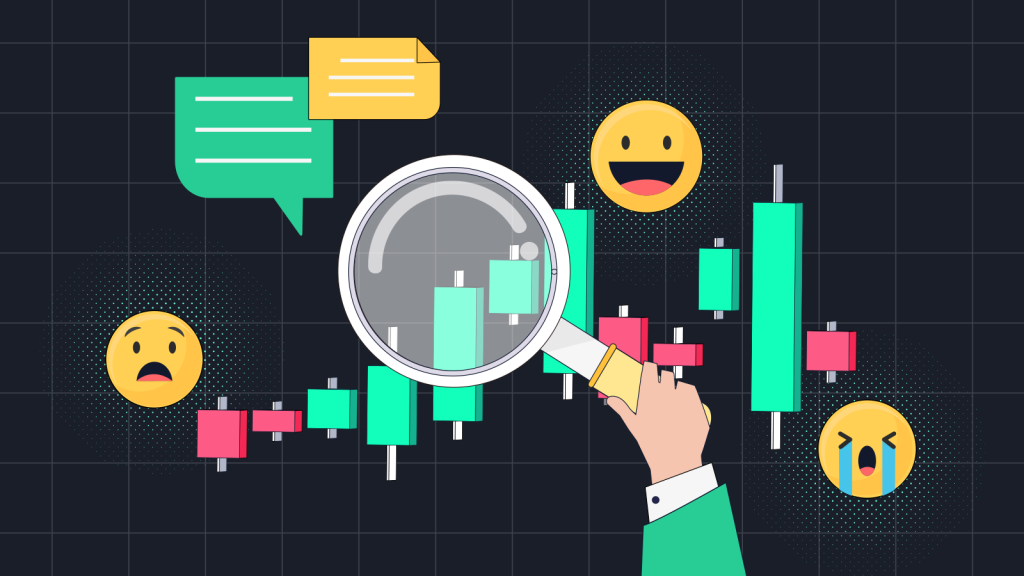Introduction
Ever wondered why crypto prices can skyrocket one week and crash the next even without major news? The answer lies in market sentiment in crypto the collective emotional state of traders and investors.
In traditional finance and crypto alike, emotion often drives price action more than logic. Learning to understand and analyze market sentiment can give you a serious edge as a trader.
This guide breaks down how sentiment works, tools to track it, and how you can trade smarter by keeping emotions in check.

What Is Market Sentiment in Crypto?
Market sentiment in Crypto refers to the overall mood or attitude of investors toward a particular market or asset. It’s shaped by:
- News and media
- Social media trends
- Fear and greed
- Global events
- Influencer commentary
In crypto, where speculation is high and regulation is light, sentiment can swing wildly — and prices follow fast.
Types of Market Sentiment in Crypto
1. Bullish Sentiment
- Optimism, confidence, and belief in rising prices.
- Traders are buying or holding long positions.
- Often leads to upward price trends (bull runs).
2. Bearish Sentiment
- Fear, pessimism, or distrust in the market.
- Investors sell or short assets.
- Can lead to sharp corrections or prolonged downtrends.
What Influences Market Sentiment in Crypto?
- News Headlines
- Regulatory announcements, hacks, ETF approvals, and adoption news can drastically shift sentiment.
- Social Media & Influencers
- X (formerly Twitter), Reddit, and Telegram channels often hype coins or spread panic.
- Fear of Missing Out (FOMO)
- When traders buy in due to hype or rising prices without solid reasoning.
- Fear, Uncertainty, and Doubt (FUD)
- Negative rumors or news cause panic selling, even if they’re not fully accurate.
- Market Cycles
- Every crypto goes through phases: accumulation → uptrend → distribution → downtrend.
- Sentiment drives these phases.
How to Measure Market Sentiment
1. Fear & Greed Index (for Bitcoin)
- A score from 0 (extreme fear) to 100 (extreme greed).
- Combines volatility, social media activity, volume, and dominance.
Check it here: Alternative.me Crypto Fear & Greed Index
2. Social Listening Tools
- Tools like LunarCrush, Santiment, or IntoTheBlock track social mentions, sentiment scores, and trends.
3. Volume & Volatility
- High trading volume often means strong conviction (positive or negative).
- Sudden spikes in volatility may indicate fear or euphoria.
4. Google Trends
- Spikes in search interest for “buy Bitcoin” or “crypto crash” can be indicators of sentiment extremes.
How to Trade with Sentiment in Mind
Use Sentiment as a Signal, Not a Strategy
- Sentiment helps gauge market mood, but don’t rely on it alone combine it with technical and fundamental analysis.
Fade the Crowd at Extremes
- Contrarian trading is popular in crypto. When sentiment is at extreme fear, smart traders look for buy opportunities.
- During extreme greed, consider taking profits or reducing exposure.
Don’t Let Emotions Dictate Trades
- Create a trading plan with entry/exit points and stick to it.
- Use stop-loss and take-profit levels to prevent emotion-based decisions.
Examples of Sentiment-Driven Events
- Elon Musk tweets: Caused massive DOGE price movements in 2021.
- China crypto bans: Often triggered panic across all markets.
- FTX collapse: Sparked widespread fear and a sharp sell-off.
- Bitcoin Halving Hype: Historically increases bullish sentiment pre-event.
Conclusion
In crypto, where logic often takes a backseat to emotion, understanding market sentiment is a powerful tool. It won’t predict the future, but it will help you read the room and make better decisions. It is also important to learn about cryptocurrency charts
At Crypto Relic, we encourage traders to stay informed, think independently, and combine sentiment with sound analysis. Remember: in a market driven by emotions, staying calm is your biggest advantage.
1 thought on “Market Sentiment in Crypto”